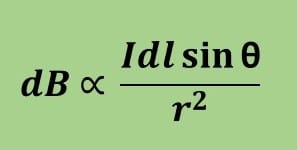The Biot Savart Law is an equation that describes how a constant electric current generates a magnetic field. It connects the magnetic field to the electric current’s magnitude, direction, length, and proximity. Both Ampere’s circuital law and Gauss’s theorem are consistent with Biot–Savart law. The Biot-Savart law is crucial to magnetostatics, serving in a similar capacity as Coulomb’s law.

Table of Contents
Biot Savart Law in Simple Words
In simpler words, the Biot-Savart Law explains how an electric current flowing through a wire generates a magnetic field around it. The strength of this magnetic field depends on the amount of current flowing through the wire and the distance from the wire. If you increase the current or move closer to the wire, the magnetic field will become stronger. This law is used to calculate the magnetic field produced by different current-carrying devices, such as wires, coils, and solenoids.
Statement of Biot Savart Law
According to the statement of Biot Savart Law, the magnetic flux density, dB, is proportional to the length of the element dl, the current I, the sine of the angle, and between the direction of the current and the vector joining a given point of the magnetic field and the current element, and is inversely proportional to the square of the given point’s distance from the current element, r.




Where k is a constant that is determined by the magnetic characteristics of the medium and the system of units used. We can also write the formula as:
d𝐵 = (μ₀/4π) * (𝐼 * d𝐿 x ẑ) / r^2
where:
- d𝐵 is the magnetic field at a particular point
- μ₀ is the magnetic constant (a physical constant with a value of 4π x 10^-7 T m A^-1)
- 4π is a mathematical constant (approximately 12.57)
- 𝐼 is the current flowing through a small length element of the wire
- d𝐿 is the length of that small element of the wire
- x is the vector cross product symbol
- ẑ is a unit vector in the direction of the observer (perpendicular to the plane of the wire element and the observer)
- r is the distance between the small element of the wire and the observer.
The Biot-Savart Law essentially states that the magnetic field at a point is proportional to the current and length element of the wire, and inversely proportional to the distance from the wire.
Daily Life Examples of Biot Savart Law
- Electric Motors: Electric motors are devices that convert electrical energy into mechanical energy. They use the Biot-Savart Law to generate a magnetic field that rotates the motor’s armature. The current-carrying wire produces a magnetic field around the motor, which interacts with the magnetic field produced by a permanent magnet, causing the motor to spin.
- Loudspeakers: Loudspeakers use the Biot-Savart Law to convert electrical signals into sound waves. When an electrical current flows through a coil of wire in the speaker, it produces a magnetic field that interacts with the magnetic field of a permanent magnet. This interaction creates a force that moves the speaker cone, producing sound waves.
- MRI Scanners: Magnetic Resonance Imaging (MRI) scanners use the Biot-Savart Law to create detailed images of the body’s internal organs and tissues. The scanner uses strong magnetic fields generated by superconducting coils to align the protons in the body’s water molecules. The Biot-Savart Law is used to calculate the magnetic field strength and direction needed to create the desired image.
- Induction Cooktops: Induction cooktops use the Biot-Savart Law to heat pots and pans. They use a rapidly changing magnetic field to induce an electric current in the metal pot or pan. This current generates heat, which is then used to cook the food.
- Current Transformers: Current transformers are used to measure electrical current in power systems. They use the Biot-Savart Law to create a magnetic field around a current-carrying wire. This field is then used to induce a current in a secondary coil, which is used to measure the current in the primary coil.
Multiple Choice Questions
- What does the Biot-Savart Law describe?
a) The electric field produced by a steady current
b) The magnetic field produced by a steady current
c) The force on a charged particle in an electric field
Answer: b) The magnetic field produced by a steady current
- What is the Biot-Savart Law used for?
a) To calculate the electric field around a charged particle
b) To calculate the magnetic field around a steady current
c) To calculate the force on a charged particle in an electric field
Answer: b) To calculate the magnetic field around a steady current
- Which physical constant is used in the Biot-Savart Law?
a) Coulomb’s constant
b) Planck’s constant
c) Permeability of free space
Answer: c) Permeability of free space (also denoted by μ₀)
Numerical Problems with Hints
- A straight wire of length 2 meters carries a current of 4 amperes. What is the magnetic field 10 cm away from the wire?
Hint: Use the formula for the magnetic field of a long straight wire in the Biot-Savart Law. Make sure to convert the distance into meters and the current into amperes.
- A circular wire of radius 5 cm carries a current of 2 A. What is the magnetic field at a point located 10 cm away from the center of the circle?
Hint: Use the formula for the magnetic field of a circular loop in the Biot-Savart Law. Make sure to convert the radius and the distance into meters and the current into amperes.
- A wire of length 10 meters is bent into a semicircular loop with a radius of 5 meters. The wire carries a current of 6 amperes. What is the magnetic field at the center of the loop?
Hint: Divide the semicircle into small segments and use the formula for the magnetic field of a straight wire in the Biot-Savart Law to find the magnetic field at the center of each segment. Sum the magnetic fields of all the segments to find the total magnetic field at the center of the loop.
- Two long parallel wires are separated by a distance of 20 cm. The wires carry currents of 3 A and 4 A in opposite directions. What is the magnetic field at a point located 10 cm away from the wire carrying the larger current?
Hint: Use the formula for the magnetic field of a long straight wire in the Biot-Savart Law to find the magnetic field due to each wire separately. Use the principle of superposition to find the total magnetic field at the point of interest.
Magnetic Flux Density
The force acting per unit current per unit length on a wire placed at right angles to the magnetic field is described as magnetic flux density (B).
Tesla (T) or Kgs-2A-1 are the units of B.
B is a vector quantity B=F/Il, where l is the length of the wire, F denotes the total force exerted on the wire, and I denotes the current flowing through the wire.
Applications of Biot Savart law
Some of the applications of Biot Savart law are given below:
- Magnetic Field due to steady current in an infinitely long straight wire can be determined
- The force between two long and parallel current-carrying conductors can be calculated
- The Magnetic Field along the axis of a circular current-carrying coil can be determined
- The Magnetic Field at the center of a current-carrying arc can be analyzed
Summary
- The magnetic flux density is proportional to the element length, current, sine of the angle, and the vector linking a given point of the magnetic field and the current element, and is inversely proportional to the square of the provided point’s distance from the current element.
- Electric current is the rate of flow of negative charges in a conductor.
- Magnetic flux density is the force acting per unit current per unit length on a wire positioned at right angles to the magnetic field (B).
Frequently Asked Questions
Some of the frequently asked questions are given below:
1. What is magnetic permeability?
The resistance of a material to a magnetic field, or the amount to which a magnetic field may permeate through a substance, is measured by magnetic permeability.
2. What is surface charge density?
Surface charge density (σ) is the amount of charge per unit area, measured in coulombs per square meter (C⋅m−2), at any point on a two-dimensional surface charge distribution.
3. What is ampere’s law?
According to Ampere’s law, the integral of magnetic field density (B) along an imaginary line is equal to the product of free space permeability and current enclosed by the path.
Direct current (DC) and alternating current (AC) are the two types of current electricity (AC). Electrons go in one direction with a direct current. Direct current is generated by batteries. Electrons move in both directions in alternating currents. AC electric current is generated by power plants.
The pace at which electrons flow past a location in a complete electrical circuit is known as current. At its most basic level, current measures the number of electrons (also known as “electrical charge”) traveling across a circuit in a certain amount of time.
Related Topic
- BCl3 Lewis Structure in four simple steps - November 1, 2023
- PH3 Lewis Structure in four simple steps - October 8, 2023
- PF3 Lewis structure in four simple steps - September 24, 2023


